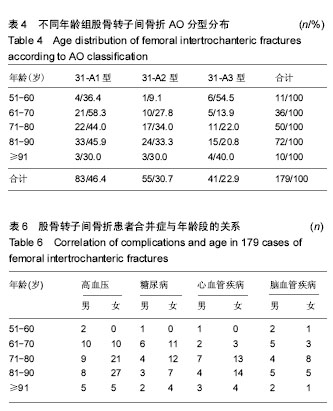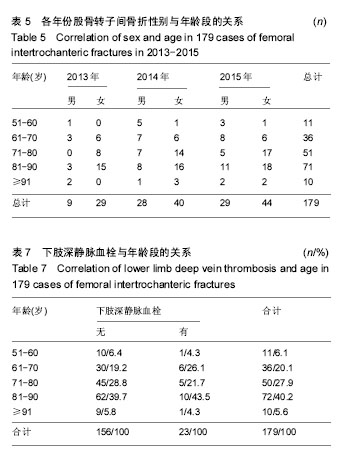中国组织工程研究 ›› 2018, Vol. 22 ›› Issue (8): 1167-1172.doi: 10.3969/j.issn.2095-4344.0133
• 骨组织构建 bone tissue construction • 上一篇 下一篇
股骨转子间骨折179例流行病学调查:天津医科大学总医院2013至2015年就诊资料分析
梁玉柱1,郭洪刚2
- 1天津医科大学,天津市 300052;2天津医科大学总医院,天津市 300052
Epidemiological analysis of femoral neck fractures in 179 patients based on the case data from the General Hospital of Tianjin Medical University between 2013 and 2015
Liang Yu-zhu1, Guo Hong-gang2
- 1Tianjin Medical University, Tianjin 300052, China; 2the General Hospital of Tianjin Medical University, Tianjin 300052, China
摘要:
文章快速阅读:
.jpg) 文题释义:
股骨转子间骨折稳定性:骨折的稳定与否是分型的重要依据与核心参考,其决定性因素包括以下2个方面:①内侧弓的完整性(小转子是否累及,股骨矩是否完整);②后侧皮质的粉碎程度(大转子的粉碎程度)。
Evans 分型:重点在于描述转子间骨折原始的稳定性和复位后的稳定性,而稳定性的关键在于后内侧骨皮质的连续性是否存在或复位后能否恢复。根据定义,EvansⅠ、EvansⅡ型属于稳定骨折,其他类型属于不稳定骨折。
文题释义:
股骨转子间骨折稳定性:骨折的稳定与否是分型的重要依据与核心参考,其决定性因素包括以下2个方面:①内侧弓的完整性(小转子是否累及,股骨矩是否完整);②后侧皮质的粉碎程度(大转子的粉碎程度)。
Evans 分型:重点在于描述转子间骨折原始的稳定性和复位后的稳定性,而稳定性的关键在于后内侧骨皮质的连续性是否存在或复位后能否恢复。根据定义,EvansⅠ、EvansⅡ型属于稳定骨折,其他类型属于不稳定骨折。
.jpg) 文题释义:
股骨转子间骨折稳定性:骨折的稳定与否是分型的重要依据与核心参考,其决定性因素包括以下2个方面:①内侧弓的完整性(小转子是否累及,股骨矩是否完整);②后侧皮质的粉碎程度(大转子的粉碎程度)。
Evans 分型:重点在于描述转子间骨折原始的稳定性和复位后的稳定性,而稳定性的关键在于后内侧骨皮质的连续性是否存在或复位后能否恢复。根据定义,EvansⅠ、EvansⅡ型属于稳定骨折,其他类型属于不稳定骨折。
文题释义:
股骨转子间骨折稳定性:骨折的稳定与否是分型的重要依据与核心参考,其决定性因素包括以下2个方面:①内侧弓的完整性(小转子是否累及,股骨矩是否完整);②后侧皮质的粉碎程度(大转子的粉碎程度)。
Evans 分型:重点在于描述转子间骨折原始的稳定性和复位后的稳定性,而稳定性的关键在于后内侧骨皮质的连续性是否存在或复位后能否恢复。根据定义,EvansⅠ、EvansⅡ型属于稳定骨折,其他类型属于不稳定骨折。摘要
背景:随着人均寿命的延长,骨质疏松人数的增加,老年人发生股骨转子间骨折的概率呈上升趋势。由于老年患者多伴有较多的内科病不能耐受长期卧床,保守治疗病死率高,目前多主张对有条件的患者尽早行手术治疗。
目的:探讨股骨转子间骨折的发病情况及其流行病学分布特点。
方法:对天津医科大学总医院2013至2015年就诊的179例股骨转子间骨折患者的数字影像资料和基本资料进行回顾性分析,筛选出50岁以上的股骨转子间骨折患者,记录并比较其年龄、性别、致伤原因、骨折类型、主要伴发病的分布以及治疗方式、住院天数等资料。
结果与结论:①共纳入研究股骨转子间骨折患者179例,其中男66例(36.9%)、女性113例(63.1%);平均年龄为(76.98±9.73)岁,其中81-90岁所占比例最高(71例,39.7%);随着年龄的增长,因跌倒造成的髋部骨折显著增加;②AO分型中31-A1型所占比例最高(46.4%),31-A3型所占比例最低(22.9%);Evans分型中Ⅰ型所占比例最高(50.3%),Ⅴ型所占比例最低(2.2%);③全组手术治疗占93.3%(167/179),非手术治疗占6.7% (12/179);④在51-60岁组股骨转子间骨折患者中,男性均多于女性;在61-70岁组患者中,除2013年女性多于男性外,也均是男性患者多于女性;在71-80岁与81-90岁组患者中,女性患者均多于男性;在≥90岁组患者中,男女性别差异无显著性意义;⑤结果提示,股骨转子间骨折是以老年人占绝大多数、以跌倒为主要致伤原因的骨质疏松性骨折;老年人股骨转子间骨折手术治疗虽然有较大风险,但仍是其主要有效治疗手段;股骨转子间骨折逐年上升,其中71-90岁组所占比例较高,女性高于男性。
中国组织工程研究杂志出版内容重点:组织构建;骨细胞;软骨细胞;细胞培养;成纤维细胞;血管内皮细胞;骨质疏松;组织工程
ORCID: 0000-0002-2440-4742(梁玉柱)
中图分类号:



.jpg) 文题释义:
股骨转子间骨折稳定性:骨折的稳定与否是分型的重要依据与核心参考,其决定性因素包括以下2个方面:①内侧弓的完整性(小转子是否累及,股骨矩是否完整);②后侧皮质的粉碎程度(大转子的粉碎程度)。
Evans 分型:重点在于描述转子间骨折原始的稳定性和复位后的稳定性,而稳定性的关键在于后内侧骨皮质的连续性是否存在或复位后能否恢复。根据定义,EvansⅠ、EvansⅡ型属于稳定骨折,其他类型属于不稳定骨折。
文题释义:
股骨转子间骨折稳定性:骨折的稳定与否是分型的重要依据与核心参考,其决定性因素包括以下2个方面:①内侧弓的完整性(小转子是否累及,股骨矩是否完整);②后侧皮质的粉碎程度(大转子的粉碎程度)。
Evans 分型:重点在于描述转子间骨折原始的稳定性和复位后的稳定性,而稳定性的关键在于后内侧骨皮质的连续性是否存在或复位后能否恢复。根据定义,EvansⅠ、EvansⅡ型属于稳定骨折,其他类型属于不稳定骨折。